Associate Prof. Nguyen Thi Chinh is among the first to bring various varieties of mushrooms to Vietnam, which are now widely cultivated in many small and large farms across the country. She is lovingly called the “Mushroom Queen” by her associates and many people.
THE WAY TO INTRODUCE MUSHROOMS TO VIETNAM
We paid a visit to the mushroom cultivating farm on an area of over 15,000m2 run by the family of Associate Prof. Nguyen Thi Chinh in Gia Lam District of Hanoi. She seemed so happy when guiding us on a tour around the farm with varieties of mushrooms, including the rare varieties of Ling-zhi and monkey-headed mushrooms, which were almost ready for harvest.
Viewing her spacious farm where bundles of mushrooms that are as valuable as medicine are growing, we could imagine what great efforts and tough challenges that the owner had endured. Difficulties could not prevent the female scientist from attaining her goal; to bring mushrooms from abroad to grow in Vietnam.
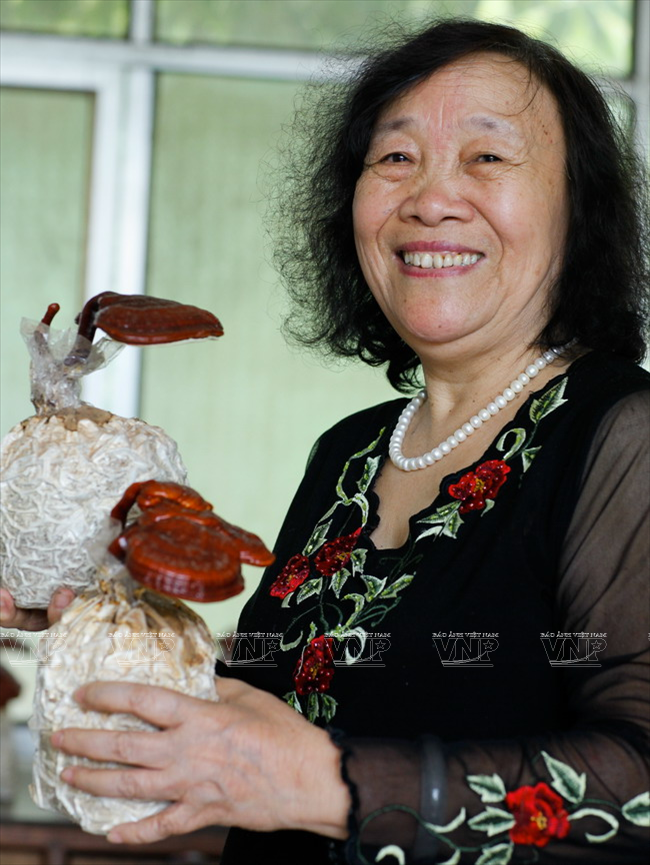
Associate Prof. Nguyen Thi Chinh is one of the first people to bring new types of mushroom
into cultivation in Vietnam. Photo: Viet Cuong/VNP
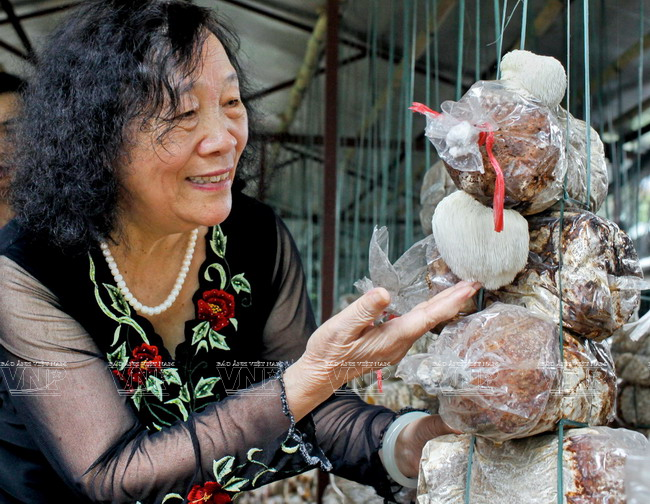
Associate Prof. Nguyen Thi Chinh with monkey-headed mushrooms (Norugongdengi-beoseot)
which are cultivated in the Linh-zhi Co.,Ltd. Photo: Viet Cuong/VNP
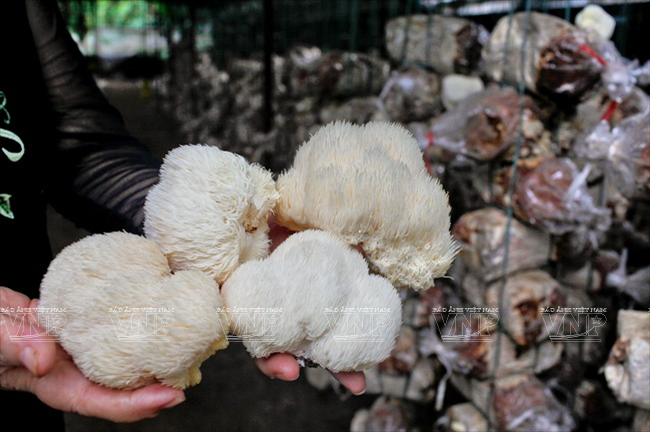
Monkey-headed mushroom is one of the highly appreciated types of medicinal fungi. Photo: Viet Cuong/VNP
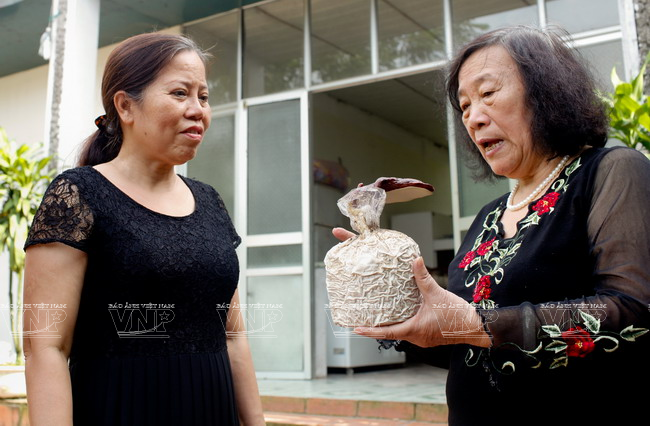
Associate Prof. Nguyen Thi Chinh introduces linh-zhi mushrooms of over 3 months to a customer.
Photo: Viet Cuong/VNP
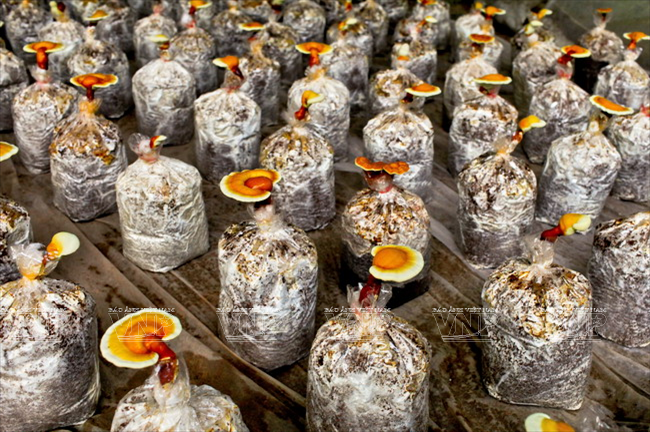
Linh-zhi mushrooms over one month old at the farm of the Linhzhi Co.,Ltd. Photo: Viet Cuong/VNP |
“I am aware of the significance of mushrooms, and the need to support poor farmers to get rid of their poverty by growing mushrooms on their land. It became a strong impetus for me on the long road to achieve my goal in my homeland,” Chinh said.
We walked along the concrete-paved road that led to the mushroom-breeding stores while hearing her stories about how she brought mushrooms to grow in Vietnam.
In the 70s, Chinh entered college, and then did post-graduate study in the former country of Czechoslovakia where she learnt that the local farmers and those from other European countries used farm waste in raising mushrooms on a large scale, from which they earned a high income. Chinh thought of her homeland, Vietnam, which is an agricultural country and where there is abundant waste from growing rice, sugar-cane and sawdust from cutting down trees. However the farmers didn’t know how to recycle them for useful purposes and to prevent environmental pollution. In addition, the tropical weather with high humidity in Vietnam is very suitable for raising mushrooms.
Based on these advantages, in 1973, after receiving an MA degree, Chinh decided to select the high-output mushroom varieties raised in European countries and bring them to Vietnam for experimental cultivation.
In those years, mushroom cultivation was still unfamiliar to the Vietnamese people, hence there was a shortage of necessary conditions for mushroom raising, such as a lab, space for strain multiplication, production technology, and a consumer market. To deal with those difficulties, Chinh used her own bed to cultivate mushrooms and her house of 16m2 became a lab for her experiments.
After many times of trying to grow mushrooms and failing, she decided to go back to Czechoslovakia to undertake her doctorate, along with doing more research on mushrooms. Her efforts were rewarded, because in 1986, she received a patent from Czechoslovakia for her research, “Production of Mushrooms Using Micro-biology Fermented Technology without Sterilisation”. In 1987, she successfully defended her MSc thesis on “Micro-organisms in Mushroom Cultivation Technology”. Her project was applied to mushroom production in Czech farms that brought a double output for the local farmers.
TO BECOME THE “MUSHROOM QUEEN”
Returning home, Chinh conducted experimental mushroom cultivation with some varieties in the rural areas. She went to the farms to instruct the local farmers on cultivating mushrooms from the farming and forestry waste available in their localities.
She implemented again in Vietnam the project to cultivate oyster mushrooms on non-sterilised straw which she had conducted previously in Czechoslovakia with good results, and the test cultivation had a high output beyond expectations. That positive result opened ways for large-scale mushroom production in farms and production units in Vietnam due to its simple procedures, with high output of from 80% to 100% from the raw materials. Currently, this kind of mushroom is cultivated in many localities nationwide, including northwestern Son La and Lai Chau, northern Thai Binh, central Nghe An, the Central Highlands Lam Dong and Dak Lak, and southern Vinh Long provinces.
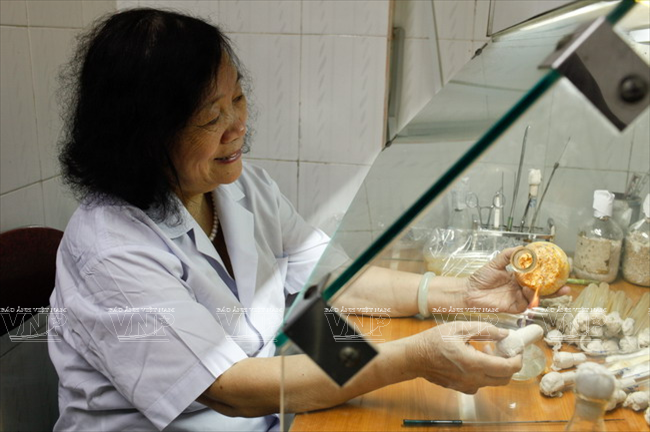
Associate Prof. Nguyen Thi Chinh collects Dong trung ha thao grown in tubes. Photo: Viet Cuong/VNP
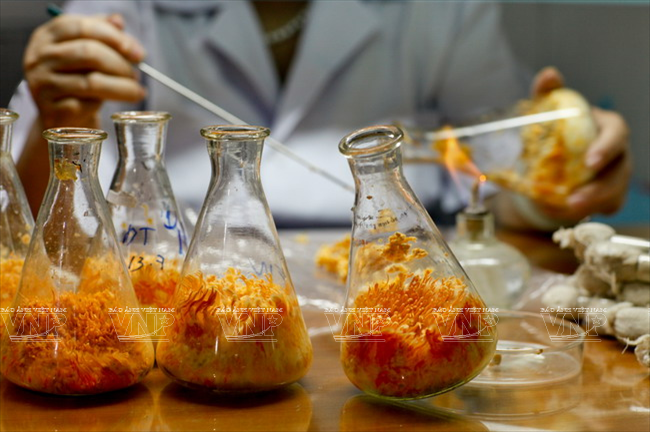
Dong trung ha thao (Cordyceps sinensis) is considered a panacea. Photo: Viet Cuong/VNP
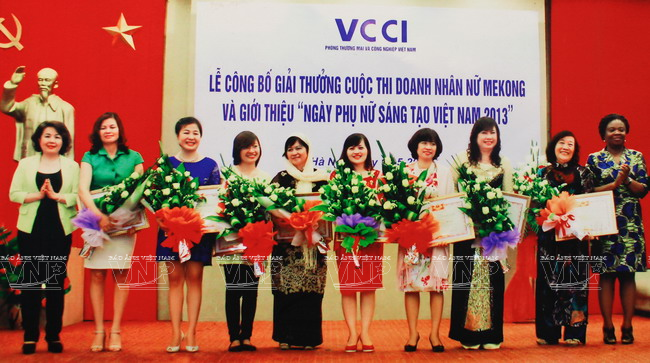
Associate Prof. Nguyen Thi Chinh (second from the right) at the Ceremony of presenting
the Mekong Businesswomen’s Award and introducing the “Vietnamese Creative Women’s Day 2013”. Photo: File
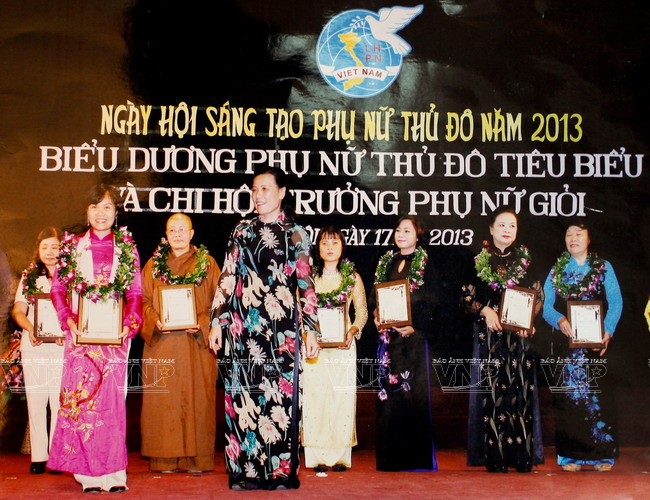
Associate Prof. Nguyen Thi Chinh (first from right) receives a prize at
the Hanoi Creative Women’s Day 2013. Photo: Viet Cuong/VNP |
Although she had successfully cultivated various varieties of mushrooms for meals and medicine, Chinh focused more on the production of Ling-zhi mushrooms due to their high quality and value. She established her own company that specialised in producing Ling-zhi mushrooms. As far as she knows, other countries including China, South Korea and Japan, have paid much attention to research and application of mushrooms to medicine production thanks to its effectiveness for the treatment of some kinds of diseases such as high blood pressure, diabetes, hepatitis B, and especially cancer.
Thus, the technology to cultivate Ling-zhi mushrooms initiated by Associate Prof. Nguyen Thi Chinh became the first to be applied in Vietnam. With this project, in 2002 she was presented the WIFOTEC Award - an honorable prize to encourage creativity in science and technology in Vietnam. Her research projects on Ling-zhi mushrooms have been highly praised both at home and abroad, and products made from Ling-zhi mushrooms by her company are now widely used domestically, including Ling-zhi powder, Ling-zhi spore raw materials and Ling-zhi spore pills, cordycepsroberti, cordycepsmilitaris, and monkey-headed mushrooms.
At present, mushroom cultivation is strongly developing in Vietnam, both in scale and quality. Varieties of “Made in Vietnam” mushrooms are available not only for domestic consumption, but also for export.
Associate Prof. Chinh has reached her goal to make mushroom cultivation a way to help farmers get rid of poverty and to make medicine to fight against diseases, besides its high exporting value./.
Story: Thao Vy - Photos: Viet Cuong